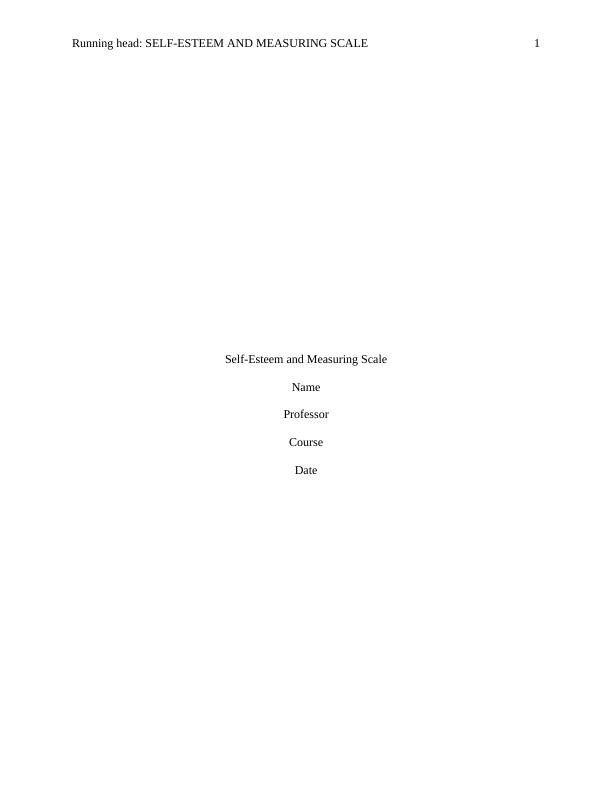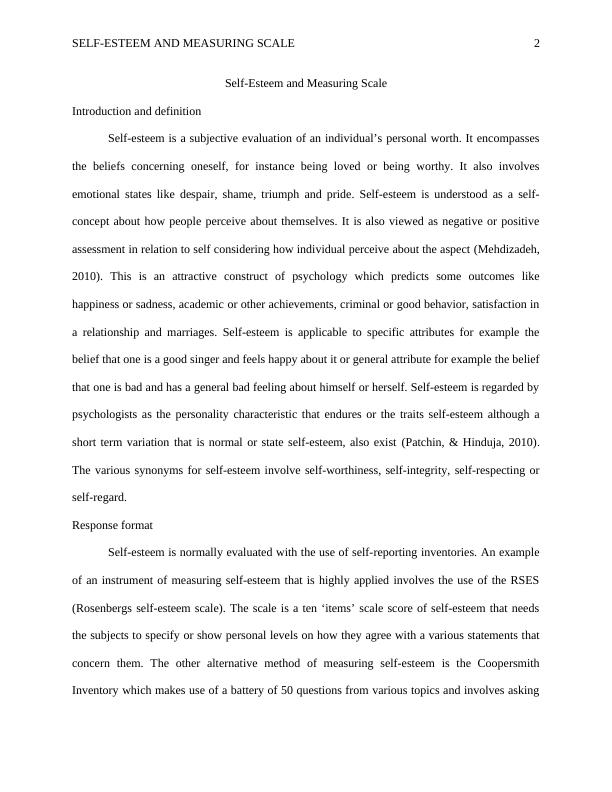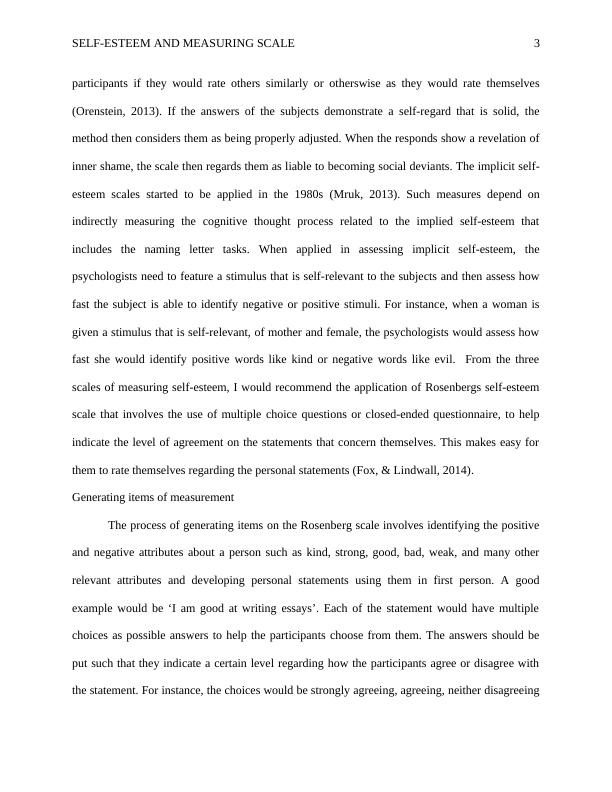Self-Esteem and Measuring Scale
Added on 2022-11-10
7 Pages1046 Words220 Views
Running head: SELF-ESTEEM AND MEASURING SCALE 1
Self-Esteem and Measuring Scale
Name
Professor
Course
Date
Self-Esteem and Measuring Scale
Name
Professor
Course
Date

SELF-ESTEEM AND MEASURING SCALE 2
Self-Esteem and Measuring Scale
Introduction and definition
Self-esteem is a subjective evaluation of an individual’s personal worth. It encompasses
the beliefs concerning oneself, for instance being loved or being worthy. It also involves
emotional states like despair, shame, triumph and pride. Self-esteem is understood as a self-
concept about how people perceive about themselves. It is also viewed as negative or positive
assessment in relation to self considering how individual perceive about the aspect (Mehdizadeh,
2010). This is an attractive construct of psychology which predicts some outcomes like
happiness or sadness, academic or other achievements, criminal or good behavior, satisfaction in
a relationship and marriages. Self-esteem is applicable to specific attributes for example the
belief that one is a good singer and feels happy about it or general attribute for example the belief
that one is bad and has a general bad feeling about himself or herself. Self-esteem is regarded by
psychologists as the personality characteristic that endures or the traits self-esteem although a
short term variation that is normal or state self-esteem, also exist (Patchin, & Hinduja, 2010).
The various synonyms for self-esteem involve self-worthiness, self-integrity, self-respecting or
self-regard.
Response format
Self-esteem is normally evaluated with the use of self-reporting inventories. An example
of an instrument of measuring self-esteem that is highly applied involves the use of the RSES
(Rosenbergs self-esteem scale). The scale is a ten ‘items’ scale score of self-esteem that needs
the subjects to specify or show personal levels on how they agree with a various statements that
concern them. The other alternative method of measuring self-esteem is the Coopersmith
Inventory which makes use of a battery of 50 questions from various topics and involves asking
Self-Esteem and Measuring Scale
Introduction and definition
Self-esteem is a subjective evaluation of an individual’s personal worth. It encompasses
the beliefs concerning oneself, for instance being loved or being worthy. It also involves
emotional states like despair, shame, triumph and pride. Self-esteem is understood as a self-
concept about how people perceive about themselves. It is also viewed as negative or positive
assessment in relation to self considering how individual perceive about the aspect (Mehdizadeh,
2010). This is an attractive construct of psychology which predicts some outcomes like
happiness or sadness, academic or other achievements, criminal or good behavior, satisfaction in
a relationship and marriages. Self-esteem is applicable to specific attributes for example the
belief that one is a good singer and feels happy about it or general attribute for example the belief
that one is bad and has a general bad feeling about himself or herself. Self-esteem is regarded by
psychologists as the personality characteristic that endures or the traits self-esteem although a
short term variation that is normal or state self-esteem, also exist (Patchin, & Hinduja, 2010).
The various synonyms for self-esteem involve self-worthiness, self-integrity, self-respecting or
self-regard.
Response format
Self-esteem is normally evaluated with the use of self-reporting inventories. An example
of an instrument of measuring self-esteem that is highly applied involves the use of the RSES
(Rosenbergs self-esteem scale). The scale is a ten ‘items’ scale score of self-esteem that needs
the subjects to specify or show personal levels on how they agree with a various statements that
concern them. The other alternative method of measuring self-esteem is the Coopersmith
Inventory which makes use of a battery of 50 questions from various topics and involves asking

SELF-ESTEEM AND MEASURING SCALE 3
participants if they would rate others similarly or otherswise as they would rate themselves
(Orenstein, 2013). If the answers of the subjects demonstrate a self-regard that is solid, the
method then considers them as being properly adjusted. When the responds show a revelation of
inner shame, the scale then regards them as liable to becoming social deviants. The implicit self-
esteem scales started to be applied in the 1980s (Mruk, 2013). Such measures depend on
indirectly measuring the cognitive thought process related to the implied self-esteem that
includes the naming letter tasks. When applied in assessing implicit self-esteem, the
psychologists need to feature a stimulus that is self-relevant to the subjects and then assess how
fast the subject is able to identify negative or positive stimuli. For instance, when a woman is
given a stimulus that is self-relevant, of mother and female, the psychologists would assess how
fast she would identify positive words like kind or negative words like evil. From the three
scales of measuring self-esteem, I would recommend the application of Rosenbergs self-esteem
scale that involves the use of multiple choice questions or closed-ended questionnaire, to help
indicate the level of agreement on the statements that concern themselves. This makes easy for
them to rate themselves regarding the personal statements (Fox, & Lindwall, 2014).
Generating items of measurement
The process of generating items on the Rosenberg scale involves identifying the positive
and negative attributes about a person such as kind, strong, good, bad, weak, and many other
relevant attributes and developing personal statements using them in first person. A good
example would be ‘I am good at writing essays’. Each of the statement would have multiple
choices as possible answers to help the participants choose from them. The answers should be
put such that they indicate a certain level regarding how the participants agree or disagree with
the statement. For instance, the choices would be strongly agreeing, agreeing, neither disagreeing
participants if they would rate others similarly or otherswise as they would rate themselves
(Orenstein, 2013). If the answers of the subjects demonstrate a self-regard that is solid, the
method then considers them as being properly adjusted. When the responds show a revelation of
inner shame, the scale then regards them as liable to becoming social deviants. The implicit self-
esteem scales started to be applied in the 1980s (Mruk, 2013). Such measures depend on
indirectly measuring the cognitive thought process related to the implied self-esteem that
includes the naming letter tasks. When applied in assessing implicit self-esteem, the
psychologists need to feature a stimulus that is self-relevant to the subjects and then assess how
fast the subject is able to identify negative or positive stimuli. For instance, when a woman is
given a stimulus that is self-relevant, of mother and female, the psychologists would assess how
fast she would identify positive words like kind or negative words like evil. From the three
scales of measuring self-esteem, I would recommend the application of Rosenbergs self-esteem
scale that involves the use of multiple choice questions or closed-ended questionnaire, to help
indicate the level of agreement on the statements that concern themselves. This makes easy for
them to rate themselves regarding the personal statements (Fox, & Lindwall, 2014).
Generating items of measurement
The process of generating items on the Rosenberg scale involves identifying the positive
and negative attributes about a person such as kind, strong, good, bad, weak, and many other
relevant attributes and developing personal statements using them in first person. A good
example would be ‘I am good at writing essays’. Each of the statement would have multiple
choices as possible answers to help the participants choose from them. The answers should be
put such that they indicate a certain level regarding how the participants agree or disagree with
the statement. For instance, the choices would be strongly agreeing, agreeing, neither disagreeing

End of preview
Want to access all the pages? Upload your documents or become a member.
Related Documents
Relationship between Narcissism and Self-Efficacylg...
|7
|1365
|342
Self-esteem and Body Imagelg...
|5
|897
|113
